-
- MEDIARECYCLING
-
- Bremer Videokunstförderpreis
1999
- (gestiftet vom Filmbüro
Bremen)
- Gesellschaft für
aktuelle Kunst, GAK Bremen 1999
- Performance/Installation
-
- Dieses Projekt widmet
sich dem Videoband selbst: als Material, Körper, Zeichenträger,
Skulptur.
- Die Installation besteht
aus drei Arbeitsgängen: 1. Ein modifizierten Videorekorder,
- der das Videoband während
des Abspielens "ausspuckt" und anhäuft. Gespielt
werden
- ausrangierente VHS
Casetten des alltäglichen Fernsehkonsums, die über
private
- Zeitungsanzeigen gesammmelt
wurden.Die Bänder kleben duch die statische Aufladung
- kurzzeitig am Fernsehschirm
fest,fallen dann zu Boden und füllen so stetig den
- inszenierten Wohnraum.
-
-
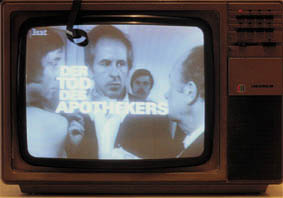
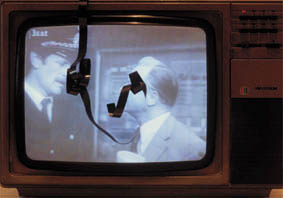
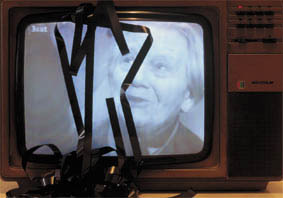
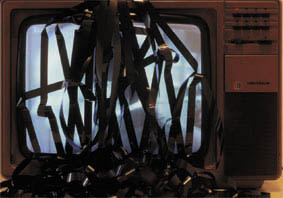
-
- This project is dedicated
to the videotape itself: as material, as body,
- as signifier and as sculpture.
There are three parts to this piece:
- 1. A modified VCR "spits"
out tape while playing. The tapes contain old recordings
- of daily TV consumption,
which had been gathered through the personals.
- The tapes, because of
static, briefly stick to the surface of the monitor before
- they fall to the ground,
slowly filling the installation space.
-

-
-
-
-
- 2. Die angehäuften
losen Bänder werden mechanisch mit der Schere geschnittenund
- mit Papierkleber geklebt
und zu neuen Bändern zusammengestellt. Da das Videoband
- selbst abstrakt, unvisuell
ist, kann der Editingvorgang kaum gesteuert werden.
-
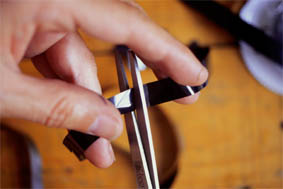
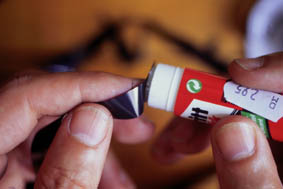
-
- 2. sections of those tapes
are being randomly chosen, cut with a scissors, then taped back
together in a different order.
- As the tape material is opaque,
the editing process becomes unpredictable and can not be controlled.
-
-
-
- 3. Die neugestalteten
Bänder werden live in den Rekorder gespeist und abgespielt.
- Durch den mechansichen
Schnitt (der sonst nur elektronisch gemacht wird) enstehen
- der Medienredundanz konträre
Audiovisionen: Die Bilder stehen Kopf, laufen rüchwärts,
- sind gestört, (Schichtrückseite),übersteuertern
im Ton, Bild und Tonebene sind zeitlich versetzt.
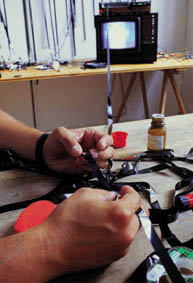
 .
.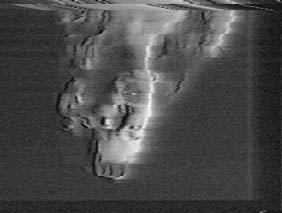
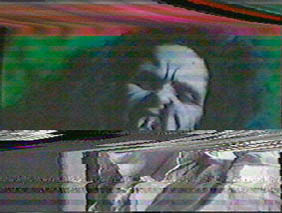
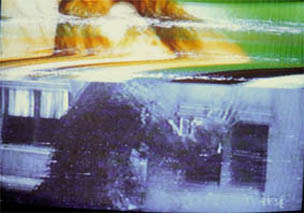
- 3. These newly designed
tapes are being fed back into and played back by the modified
VCR.
- Because the editing is
done mechanically and not, as would usually be the case,
- electronically, the resulting
audio-visions run counter to the conventions of "daily TV":
- images are upside down,
playing backwards,oversteer in sounds. Image and sound layer
are out of sync.
-
-
-
-
- Der Versetzung der Bild/Tonebene
ergibt sich aus der Positionierung des
Videokopf zum
- Tonabnehmer(siehe Zeichnung).
Die Form der Bildschnitte im Fernsehbild sind "analog"
zum
- mechanischen Schnitt
im Band, aber um 90 Grad versetzt.
-
-
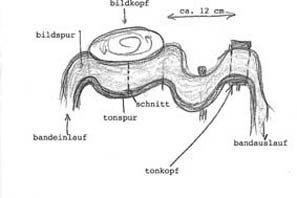
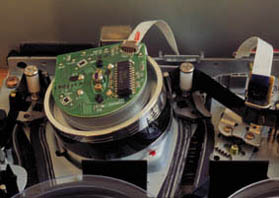
- The time delay between
image and sound results from the position of the video head
- and the sound pick-up
(see diagram). The form of the cut of the picture are "analogical"
- to the real cut in the
tape but displaced by a 90 degree angle.
-
- load movie
-
-
- back to home page








 .
.












 .
.



